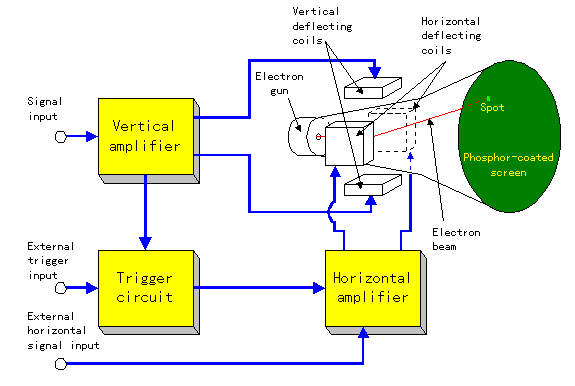The oscilloscope is the equipment to see the changing signal voltage directly. Basically, it suits to observe the periodically repeated signal. It is difficult to see the signal with the irregular period or occurs the only once. There is equipment which has the memory to observe the signal which occurs the only once, too.
Here, I introduce the basic operation principle of the oscilloscope (or synchroscope).

 Screen display principle of the oscilloscope Screen display principle of the oscilloscope
The oscilloscope shows the time with the horizontal axis (the X axis) and shows the voltage with the vertical axis (the Y axis).
As for the screen, the CRT (Cathode-Ray Tube) is often used. It displays in the principle which is the same as the TV. That is, it displays the signal wave form with the deflection of the electron beam (it moves to upper and lower either side).

 Control of the electron beam Control of the electron beam
The voltage to observe is added to the upper and lower deflecting coils. With this, the electron beam moves to upper and lower according to the signal voltage to observe.
The voltage for the scan is added to the deflecting coils on the right and the left side. The sawtooth wave is used for this voltage. The electron beam makes move from the left end of the screen to the right end at the constant speed. When moving from the right end to the left end, it makes move fast. The line which moves from the right end to the left end(fly-back line) doesn't have to be able to be seen. It depends on the kind of the oscilloscope but in the part of the fly-back line, it is ordinary to stop the electron beam.

 Y axis control Y axis control
The signal voltage to observe is gained. The efficiency of the signal amplifier is important.
When there is distortion in the amplifier, the wave-form which is different from the actual signal appears in the screen. Generally, as for the classy machine, the high frequency characteristic becomes good.

 X axis control X axis control
It makes the electron beam move from the left to the right at the constant speed in the time. Even if it made move without synchronizing with the signal, the wave-form which was stationary can not be shown on the screen. It is necessary to make move at the period which is the same as the period of the input signal or its integer duple period.
In Japan, sometimes uses the name which is called the oscilloscope and the synchroscope by the difference of the operation.
Both the oscilloscope and the synchroscope, the horizontal axis shows the time and the vertical axis shows the voltage.
The difference is the operation of the horizontal axis (the time axis).
To make the wave-form of the input signal on the scope stationary, it is necessary to make the scan period of the horizontal axis synchronize with the input signal. Therefore, the way of making the scan period synchronize with the input signal becomes necessary.
 The scan control with the oscilloscope The scan control with the oscilloscope
The scan of the horizontal axis of the oscilloscope is always done. That the electron beam moves from the left to the right is called the scan. It detects (the trigger) the standing-up (the voltage which was changed to the direction of the positive) of the input signal or the standing falling (the voltage which was changed to the direction of the negative) and it brings the period of the the horizontal axis scan close to the period.
The scan period which synchronizes with the signal to observe must be adjusted.
The oscilloscope can not observe the signal with the irregular period.
Also, the less than 1-cycle signal can not be observed.

 The scan control with the synchroscope The scan control with the synchroscope
The horizontal axis of the synchroscope is scanned, too. The point which is different from the oscilloscope is that scan's beginning (the position on the left of the screen) is done in the standing-up of the input signal or the standing falling. It is different from the oscilloscope and the scan period doesn't change. Because it is, the signal with the irregular period can be observed in the wave-form in the stationary condition.
Because the less than 1-cycle signal can be observed, the over-shoot or under-shoot of the square wave can be observed.
 |

